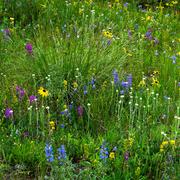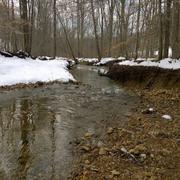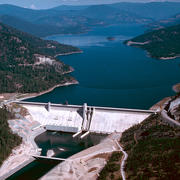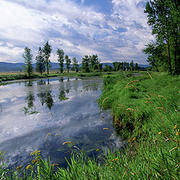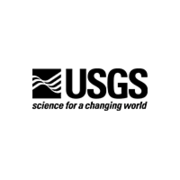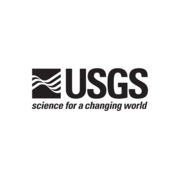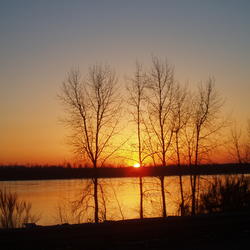Due to a lapse in appropriations, the majority of USGS websites may not be up to date and may not reflect current conditions. Websites displaying real-time data, such as Earthquake and Water and information needed for public health and safety will be updated with limited support. Additionally, USGS will not be able to respond to inquiries until appropriations are enacted. For more information, please see www.doi.gov/shutdown
Science and Decisions Center
Home
Programs L2 Landing Page
The USGS Science and Decisions Center (SDC) is an interdisciplinary organization advancing the use of science in natural resource decision making. The Center focuses on research and applications in three science areas: decision science (adaptive management and structured decision making), ecosystem services, and resilience/sustainability.
Science and Decisions Center WebsiteAbout the Science and Decisions Center
Today's natural resource managers must make effective decisions with broad–scale societal impacts.
Adaptive Management
Adaptive management is "learning by doing" and adapting based on what is learned, in an objective, science-based management strategy that explicitly recognizes and delineates uncertainty.
Ecosystem Services
Ecosystem services are attributes and outputs of ecosystems that are valued by human users. Ecosystem services are produced by ecosystem processes such as nutrient cycling, climate regulation, and maintenance of biodiversity. Ecosystems also provide marketable goods like seafood and timber.
Resilience
Resilience is the ability of a system or a community to absorb shocks and still maintain the same basic structure and functions. Management for ecological resilience seeks flexible system behaviors that can deliver ecosystem goods and services on a sustained basis.
Database of Biodiversity and Habitat Quantification Tools Used for Market-based Conservation in the United States
This dataset includes quantification tools being used or developed for habitat and biodiversity markets in the United States. These tools are designed to estimate the ecological quality or functionality of a site for conservation mechanisms such as payment for ecosystem services programs, eco-label certification programs, habitat exchanges, and conservation banking. The dataset consists of...
Geologic map of the Fort Collins 30'×60' quadrangle, Larimer and Jackson Counties, Colorado, and Albany and Laramie Counties, Wyoming
The rocks and landforms of the Fort Collins 30′ × 60′ 1:100,000-scale U.S. Geological Survey quadrangle reveals a particularly complete record of geologic history in the northern Front Range of Colorado. The Proterozoic basement rocks exposed in the core of the range preserve evidence of Paleoproterozoic marine sedimentation, volcanism, and...
Workman, Jeremiah B.; Cole, James C.; Shroba, Ralph R.; Kellogg, Karl S.; Premo, Wayne R.Descriptive models for epithermal gold-silver deposits: Chapter Q in
Epithermal gold-silver deposits are vein, stockwork, disseminated, and replacement deposits that are mined primarily for their gold and silver contents; some deposits also contain substantial resources of lead, zinc, copper, and (or) mercury. These deposits form in the uppermost parts of the crust, at depths less than about 1,500 meters below the...
John, David A.; Vikre, Peter G.; du Bray, Edward A.; Blakely, Richard J.; Fey, David L.; Rockwell, Barnaby W.; Mauk, Jeffrey L.; Anderson, Eric D.; Graybeal, Frederick T.Understanding the captivity effect on invertebrate communities transplanted into an experimental stream laboratory
Little is known about how design and testing methodologies affect the macroinvertebrate communities that are held captive in mesocosms. To address this knowledge gap, we conducted a 32‐d test to determine how seeded invertebrate communities changed once removed from the natural stream and introduced to the laboratory. We evaluated larvae survival...
Schmidt, Travis S.; Rogers, Holly; Miller, Janet L.; Mebane, Christopher A.; Balistrieri, Laurie S.Distinguishing brackish lacustrine from brackish marine deposits in the stratigraphic record: A case study from the late Miocene and early Pliocene Bouse Formation, Arizona and California, USA
Brackish marine and brackish continental environments are fundamentally different from a compositional perspective. Brackish water is often defined as having salinity lower than that of standard seawater but higher than that of freshwater, but less regard is given to the origin of the salts involved. The simple dilution of...
Bright, Jordon; Cohen, Andrew S.; Starratt, Scott W.Paleoseismic results from the Alpine site, Wasatch fault zone: Timing and displacement data for six holocene earthquakes at the Salt Lake City–Provo segment boundary
To improve the characterization of Holocene earthquakes on the Wasatch fault zone (WFZ), we conducted light detection and ranging (lidar)‐based neotectonic mapping and excavated a paleoseismic trench across an 8‐m‐high fault scarp near Alpine, Utah, located <1  km"><1 km<1 km south of the boundary...
Bennett, Scott E. K.; Duross, Christopher; Gold, Ryan D.; Briggs, Richard; Personius, Stephen; Reitman, Nadine G.; Devore, Joshua; Hiscock, Adam; Mahan, Shannon A.; Gray, Harrison; Gunnarson, Sydney; Stephenson, William J.; Pettinger, Elizabeth; Odum, Jackson K.Aeromagnetic map of Mountain Pass and vicinity, California and Nevada
Magnetic investigations of Mountain Pass and vicinity were begun as part of an effort to study regional crustal structures as an aid to understanding the geologic framework and mineral resources of the eastern Mojave Desert. The study area, which straddles the state boundary between southeastern California and southern Nevada, encompasses Mountain...
Ponce, David A.; Ponce, David A.; Denton, Kevin M.Isostatic gravity map of Mountain Pass and vicinity, California and Nevada
Gravity investigations of Mountain Pass and vicinity were begun as part of an effort to study regional crustal structures as an aid to understanding the geologic framework and mineral resources of the eastern Mojave Desert. The study area, which straddles the state boundary between southeastern California and southern Nevada, encompasses Mountain...
Ponce, David A.; Ponce, David A.; Denton, Kevin M.Geophysical and geologic maps of Mountain Pass and vicinity, California and Nevada
U.S. Geological Survey Scientific Investigations Map 3412 is a series of products that consists of geophysical and geologic maps of Mountain Pass and vicinity, California. Maps A and B (red outline in above map image) are gravity and aeromagnetic maps, respectively. The map series was begun as part of an effort to study regional crustal structures...
Ponce, David A.Thermally induced fracture of macroscale surficial granite sheets
Geologically diverse landforms around the world show indications of energetic macroscale fracture. These fractures are sometimes displayed dramatically as so-called “A-tents”, whereby relatively thin rock sheets push upwards and fracture, forming tent-like voids beneath the ruptured sheets. The origin and formation of such features has been a...
Collins, Brian D.; Stock, Greg M.; Eppes, Martha C.Geologic map of the Castle Rock 7.5' quadrangle, Arizona and California
The Castle Rock quadrangle is in the northeast corner of Chemehuevi Valley, California and Arizona. It includes the Colorado River’s entrance to the valley at the mouth of Topock Gorge and the northern outskirts of Lake Havasu City, Arizona, and the Chemehuevi Indian Tribe community of Havasu Lake, California. The map includes large parts of the...
House, P. Kyle; John, Barbara E.; Malmon, Daniel V.; Block, Debra; Beard, L. Sue; Felger, Tracey J.; Crow, Ryan S.; Schwing, Jonathan E.; Cassidy, Colleen E.Framework geologic map and structure sections along the Bartlett Springs Fault Zone and adjacent area from Round Valley to Wilbur Springs, northern Coast Ranges, California
The geologic map and accompanying report describes the extent, complexity, architecture, and evolution of the Bartlett Springs Fault Zone between Clear Lake and Round Valley, California. This fault zone is the eastern-most known active member of the San Andreas transform margin in northern California. It is of particular interest for its apparent...
McLaughlin, Robert J.; Moring, Barry C.; Hitchcock, Christopher S.; Valin, Zenon C.Bedrock mapping and seismic hazard assessment at Gold Basin landslide, Washington
The Gold Basin landslide is located along the South Fork Stillaguamish River, within the Mount Baker-Snoqualmie National Forest in western Washington State. Recent concerns related to slope stability after the 2014 State Route 530 Landslide near Oso, Washington, forced the closure of the U.S. Forest Service Gold Basin Campground in May of 2014. In...
Staisch, Lydia M.Mauna Loa Lava Flow, April 2, 1984
A USGS scientist walks along a lava flow from the April 2, 1984 Mauna Loa eruption. The scientist stops to observe a standing wave of lava at the end. The lava flow is moving at 64 km/hr (40 mph) towards Hilo, Hawai'i.
The Right Tool for the Right Job
Land managers, regulators and other participants in market-based conservation wanting to assess the ecological benefits provided by restored, enhanced and preserved land now have a one-stop shop for the quantification tools used to measure these benefits, courtesy of the USGS and the USDA.
Better Together: How Ecosystem Services and Adaptive Decision-Making Can Improve Land Management
An ecosystem services approach combined with adaptive decision-making can aid land and resource managers in administering their regions for the benefit of communities and stakeholders, according to a recent report by the U.S. Geological Survey and Resources for the Future
USGS Releases Selenium Modeling Framework for Montana and British Columbia’s Lake Koocanusa
Resource managers, regulators, and stakeholders of Montana and British Columbia’s Lake Koocanusa now have a new approach for understanding the implications of different levels of selenium, and to explore alternative selenium criteria for waters in the Lake.
Bighorn Sheep on A Desert Island: Been There, Dung That
In a finding authors are coining an "unintentional rewilding," scientists identified a cave dung deposit as belonging to bighorn sheep that became extinct on a desert island sometime between the 6th and the 20th century.


